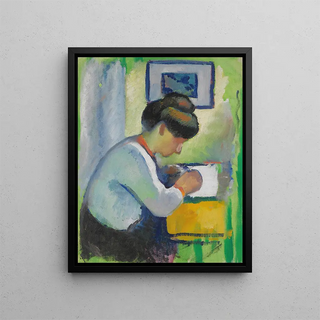Art print | Woman writing - August Macke


View from behind

Frame (optional)
August Macke's "Woman Writing" is an invitation to immerse oneself in a universe where art transcends everyday life. This painting, created in 1910, captures not only the essence of its time but also a rare intimacy—the image of a woman absorbed in the act of writing. Through this depiction, Macke transports us to a scene imbued with delicacy and reflection, where each brushstroke seems to vibrate in harmony with the thoughts of its subject. The composition, both simple and evocative, makes this work a true masterpiece, showcasing the artist's sensitivity and mastery.
Style and uniqueness of the work
August Macke's style is characterized by bold use of colors and shapes, which are part of the expressionist movement. In "Woman Writing," vivid and harmonious hues intertwine to create a luminous and joyful atmosphere. The female figure, delicately stylized, stands out against a colorful background that evokes nature or a warm interior. The woman's posture, leaning over her writing desk, suggests deep, almost spiritual concentration. This moment of solitude and creativity is elevated by Macke's chosen color palette, which elegantly dialogues with blue, yellow, and red. Every element of the composition seems to participate in a silent narrative, where the beauty of the gesture blends with the depth of thought.
The artist and his influence
August Macke, an emblematic figure of the German expressionist movement, left a mark on his era with a unique artistic vision. Born in 1887, he quickly developed a style that combines modernity and tradition, influenced by masters such as Henri Matisse and Paul Gauguin. His innovative approach to color and form paved the way for new possibilities in artistic expression. "Woman Writing" fits within this quest for authenticity and sensitivity, where art becomes a means to explore human emotions. Macke's influence is still felt today, inspiring many contemporary artists to seek harmony between the subject and its environment. His legacy

Matte finish

View from behind

Frame (optional)
August Macke's "Woman Writing" is an invitation to immerse oneself in a universe where art transcends everyday life. This painting, created in 1910, captures not only the essence of its time but also a rare intimacy—the image of a woman absorbed in the act of writing. Through this depiction, Macke transports us to a scene imbued with delicacy and reflection, where each brushstroke seems to vibrate in harmony with the thoughts of its subject. The composition, both simple and evocative, makes this work a true masterpiece, showcasing the artist's sensitivity and mastery.
Style and uniqueness of the work
August Macke's style is characterized by bold use of colors and shapes, which are part of the expressionist movement. In "Woman Writing," vivid and harmonious hues intertwine to create a luminous and joyful atmosphere. The female figure, delicately stylized, stands out against a colorful background that evokes nature or a warm interior. The woman's posture, leaning over her writing desk, suggests deep, almost spiritual concentration. This moment of solitude and creativity is elevated by Macke's chosen color palette, which elegantly dialogues with blue, yellow, and red. Every element of the composition seems to participate in a silent narrative, where the beauty of the gesture blends with the depth of thought.
The artist and his influence
August Macke, an emblematic figure of the German expressionist movement, left a mark on his era with a unique artistic vision. Born in 1887, he quickly developed a style that combines modernity and tradition, influenced by masters such as Henri Matisse and Paul Gauguin. His innovative approach to color and form paved the way for new possibilities in artistic expression. "Woman Writing" fits within this quest for authenticity and sensitivity, where art becomes a means to explore human emotions. Macke's influence is still felt today, inspiring many contemporary artists to seek harmony between the subject and its environment. His legacy






